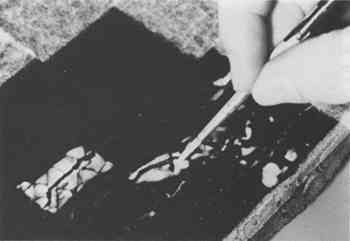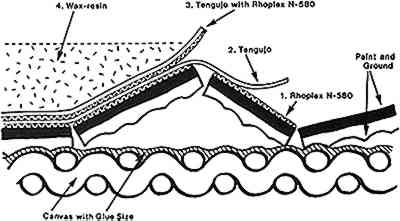USE OF A PRESSURE-SENSITIVE ADHESIVE TO FACILITATE THE TRANSFER OF A SEVERELY TENTED PAINTINGGIANFRANCO POCOBENE, & IAN HODKINSON
7 FACING PROCEDUREAssured by the results of the preliminary tests we proceeded to the treatment of the painting. Loose paint chips trapped between the cleaved ground layer and the canvas were retrieved with tweezers, documented, and saved for reattachment. Sections of the painting were coated with a thin layer of Rhoplex N-580 using a no. 2 sable brush (fig. 4). The adhesive had a tendency to solidify as globules on the end of the brush during application. Therefore, periodic cleaning of the brush with acetone was necessary to remove the drying adhesive and avoid handling difficulties. Sections of the tengujo
Because of the brittle condition of the paint film, it was decided that a second facing layer should be applied for additional support and strength. Unfortunately, application of the pressure-sensitive adhesive in dispersion form to a small test area of the first facing layer resulted in absorption of the adhesive into the facing and loss of tacking strength. Instead, the earlier idea of applying the adhesive in the form of a precast film on the tissue was used. The Rhoplex N-580 was cast by brushing a thin, even layer of the adhesive onto a large sheet of silicone-release paper pinned to a flat surface. Once the water phase of the Rhoplex N-580 had evaporated, sections of the tengujo paper (approximately 20 � 20 cm) were attached to the tacky film by laying down one edge of the paper and slowly contacting the rest of the paper with a brush. The formation of creases was avoided during this step. The tengujo paper, now with a film of the pressure-sensitive adhesive on one side, was cut in sections larger than the first facing layer but varing in size according to the extent of planar distortion in a given area. The silicone-release paper was peeled away and these sections were then applied over the first layer, again closely following the surface distortions in the painting by means of gentle pressure with a brush (fig. 6).
With the paint and ground layers secured by facing, it was now necessary to remove the canvas support and return the paint layer to plane. Wax-resin in combination with heat was chosen to facilitate the task. A wax-resin facing system based on a facing procedure developed by Keck (1981) was used. Molten wax-resin (8 parts beeswax, 2 parts Ketone Resin N, and 1 part microcrystalline wax W445) was brushed onto the facing layer to a thickness of approximately 5 mm (fig. 6). This system had three functions. First, because the wax-resin conformed exactly to topographical distortions in the paint film, it provided additional support and stiffness. Second, the molten wax-resin would act as a plasticizer during manipulation of the paint film back to plane while on the hot table. And third, the wax-resin would be the adhesive to attach the transferred painting to its new support. To properly secure the painting during removal of the stretcher and canvas, a sheet of Mylar (1 mil), cut larger than the outer dimensions of the faced painting, was laid over the wax-resin layer and attached with a warm tacking iron. The painting was then placed face down and the stretcher removed. To prevent movement of the painting during canvas removal, the edges of the Mylar sheet were pulled taut and secured to a smooth board against which the face of the painting rested. |


